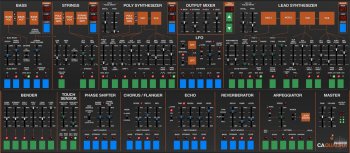REQ: Cherry Audio Quadra v1.0.4.75 MacOS

The Cherry Audio Quadra is a super-accurate and immensely improved emulation of the ARP Quadra synthesizer, originally released in 1978. It’s something of a unicorn instrument in that they’re rare, not only because ARP didn’t produce a lot of them, but also because many have been scrapped over the years as a result of their inherent unreliability. That said, the Quadra has developed something of a cult following because they were frequently used by Genesis keyboardist Tony Banks, and the late jazz legend, Joe Zawinul. And Quadras look super cool, in a here-come-the-neon-80s kind of way. (For the trainspotters, you can also find a Quadra wedged between Mickey Thomas's mustache and acres of leather in Jefferson Starship's impressively corny "Find Your Way Back" video.)
The Quadra was conceived at a time when ARP was on the verge of bankruptcy, largely due to the Avatar, a not-ready-for-prime-time and thus, poorly selling guitar synth. Though ARP made their name on monophonic synths and poly “string” synth instruments, it was clear that polyphonic instruments with instantly recallable patch storage were the way of the future, as illustrated by the wildly successful Sequential Circuits Prophet-5. But instead of putting their noses to the grindstone and developing an instrument that could go head-to-head with the Prophet-5, ARP took the cheap/easy way out and essentially combined a few existing instruments in one box - the Omni II, a glorified string ensemble, the Solus dual-oscillator monosynth, and a rudimentary bass synth. These were (sort of) controlled by an underpowered 8048 microprocessor. We say “sort of,” because its primary function was to manage the Quadra’s 16 patch storage locations, but the patch storage implementation is so ill-conceived and poorly executed, it’s hard to imagine how it made it out of R&D*. Adding insult to injury, the colorful flat “touch” buttons that were all the rage in the late-70s and early-80s were prone to not working, the chassis tended to flex, and the keyboard jutted out from the front of the instrument a few inches, making it very easy to break keys.
While we’re slugging a synth while it’s already down, another issue: The Prophet-5, and other programmable polys that followed soon thereafter were what’s known as “voice assign” instruments - essentially multiple monophonic synths under the hood, controlled by advanced microprocessors. This allowed each note to have its own independent filter and amplitude envelope curve (imagine a bunch of typical “weoooww" synth notes, each producing their own little “weeooowww” cycle as they’re played). Prior to the advent of the computer-controlled voice-assign instruments of the late 70’s, polyphonic synths and string machines were far more primitive, and would typically have just one filter and envelope generator that affected all notes played. This wasn’t too bad for sustained string or organ-type sounds, but the lack of individual note articulation was less than ideal for plucked sounds such as pianos, clavs, or the “weeoooow” sweep described above. The Quadra’s Poly Synth and Strings sections both made use of antiquated “paraphonic” organ/string machine technology, thus, no individually articulated notes.
So why would anyone in their right mind want this thing? A couple of reasons... to begin with, ARP had the good sense to incorporate a great-sounding phaser, and the Quadra allowed independent routing of the bass, strings, poly synth, or lead synth sections through it. And although the four synth sections weren't stupendous on their own, the ability to use all four at once (in various split or layered iterations) enabled large and unique tones that would be hard to create on other instruments. Did we mention that Quadras look really cool too?
The Super-Good News
Cherry Audio has seriously addressed all the dumb parts, left the great and unique parts, and wildly expanded the Quadra for an experience that blows away the real thing in every conceivable way. Unlike the original, each section is independently assignable to any region of the keyboard for endless splitting and layering flexibility. The highly limited, one-waveform poly synth's oscillator bank is greatly expanded, retaining the original's "spiky" and "hollow" waves, and adding ramp, and pulse wave with pulse-width modulation, immensely expanding its tonal palette. The odd patch storage has been replaced with Cherry Audio’s extensive, unlimited patch browsing system. And not only did we make a killer emulation of the aforementioned onboard phaser effect, we added a stereo chorus/flanger, a syncable echo, and studio-quality reverb, all individually routable for unprecedented effects flexibility. And finally, we've included a multi out version of Quadra that allows individual DAW mixer routing of each of the four sections for individual panning, using third-party effects plug-ins, or routing to separate physical outputs of a multi-output audio interface.
